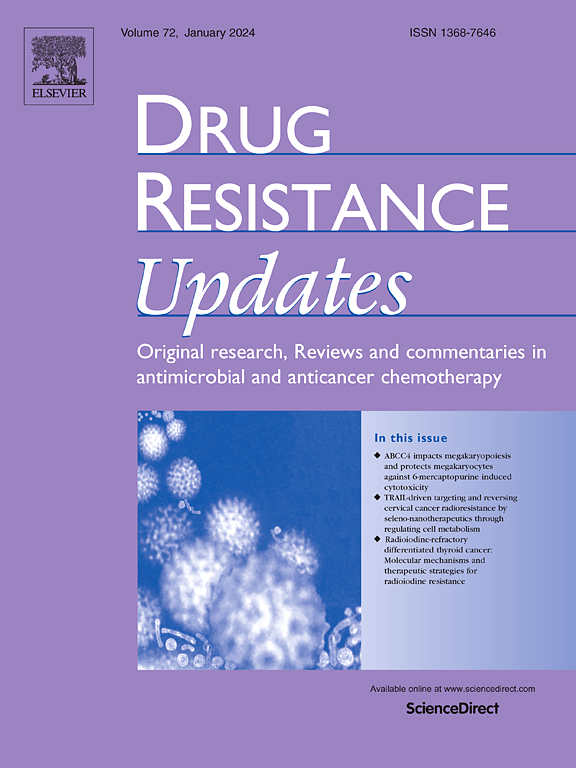Global phylogeography and antibiotic resistance characteristics of Morganella: An epidemiological, spatial, comparative genomic study
IF 15.8
1区 医学
Q1 PHARMACOLOGY & PHARMACY
引用次数: 0
Abstract
Morganella morganii has been recognized as an important opportunistic pathogen that is becoming increasingly prevalent worldwide. However, the current global evolutionary dynamics and emergence of ARGs remain obscure. The present study determined the global distribution, genomic classification, phylogeny, and monitor longitudinal resistome changes. During 1900–2024, a total of 1027 non-duplicate Morganella genomes have been reported from 49 countries. The countries with the highest number were China (433), the USA (143), and France (74). Through ANI distance analysis and core genome phylogeny, Morganella was reclassified into six species: M. morganii, M. sibonii, M. chanii, M. laugraudii, M. kristinii, M. psychrotolerans. Further analysis using cgMLST identified 87 distinct genetic clusters and 737 singleton strains, indicating a high level of multi-locus sequence type diversity and local clonal outbreaks. Bayesian evolutionary analysis revealed the most recent common ancestor year and potential global transmission routes. A total of 195 ARGs were carried by Morganella isolates, with each genome containing between 2 and 544 ARGs. The most common ARGs were associated with resistance to the following drug-classes: aminoglycosides, beta-lactam, chloramphenicol, sulfamides, and tetracycline. Twenty-one carbapenemase-encoding genes were identified in 22 countries, with blaNDM-1, blaKPC-2, blaIMP-27, blaOXA-48, blaNDM-5, blaNDM-7, and blaVIM-1 being the most prevalent. Positive correlations were observed between ARGs and mobile genetic elements, like plasmids, ISs, and Tns, indicating frequent mobilization of certain ARGs by different mobile genetic elements (p < 0.05). In conclusion, Morganella isolates that are showing an upward trend in resistance and infection rates warrant a reclassification of their taxonomy and continuous monitoring for resistance.
摩根菌的全球系统地理学和抗生素耐药性特征:一项流行病学、空间、比较基因组研究。
摩根氏菌已被认为是一种重要的机会致病菌,在世界范围内日益流行。然而,目前全球的进化动态和arg的出现仍然很模糊。本研究确定了全球分布,基因组分类,系统发育,并监测纵向抗性组的变化。在1900-2024年期间,49个国家共报告了1027个非重复摩根菌基因组。人数最多的国家是中国(433人)、美国(143人)、法国(74人)。通过ANI距离分析和核心基因组系统发育,将摩根氏菌重新划分为6种:M. morganii、M. sibonii、M. chanii、M. laugraudii、M. kristinii、M. psychrotolerans。cgMLST进一步分析鉴定出87个不同的遗传簇和737个单株菌株,表明高水平的多位点序列类型多样性和本地克隆爆发。贝叶斯进化分析揭示了最近的共同祖先年和潜在的全球传播途径。摩根菌分离株共携带195个ARGs,每个基因组含有2 ~ 544个ARGs。最常见的ARGs与对以下药物类的耐药性有关:氨基糖苷类、β -内酰胺类、氯霉素类、磺胺类和四环素类。在22个国家共鉴定出21个碳青霉烯酶编码基因,其中以blaNDM-1、blaKPC-2、blaIMP-27、blaOXA-48、blaNDM-5、blaNDM-7和blaVIM-1最为普遍。ARGs与质粒、ISs和Tns等移动遗传元件之间存在正相关,这表明某些ARGs经常被不同的移动遗传元件动员
本文章由计算机程序翻译,如有差异,请以英文原文为准。
求助全文
约1分钟内获得全文
求助全文
来源期刊

Drug Resistance Updates
医学-药学
CiteScore
26.20
自引率
11.90%
发文量
32
审稿时长
29 days
期刊介绍:
Drug Resistance Updates serves as a platform for publishing original research, commentary, and expert reviews on significant advancements in drug resistance related to infectious diseases and cancer. It encompasses diverse disciplines such as molecular biology, biochemistry, cell biology, pharmacology, microbiology, preclinical therapeutics, oncology, and clinical medicine. The journal addresses both basic research and clinical aspects of drug resistance, providing insights into novel drugs and strategies to overcome resistance. Original research articles are welcomed, and review articles are authored by leaders in the field by invitation.
Articles are written by leaders in the field, in response to an invitation from the Editors, and are peer-reviewed prior to publication. Articles are clear, readable, and up-to-date, suitable for a multidisciplinary readership and include schematic diagrams and other illustrations conveying the major points of the article. The goal is to highlight recent areas of growth and put them in perspective.
*Expert reviews in clinical and basic drug resistance research in oncology and infectious disease
*Describes emerging technologies and therapies, particularly those that overcome drug resistance
*Emphasises common themes in microbial and cancer research
 求助内容:
求助内容: 应助结果提醒方式:
应助结果提醒方式:


